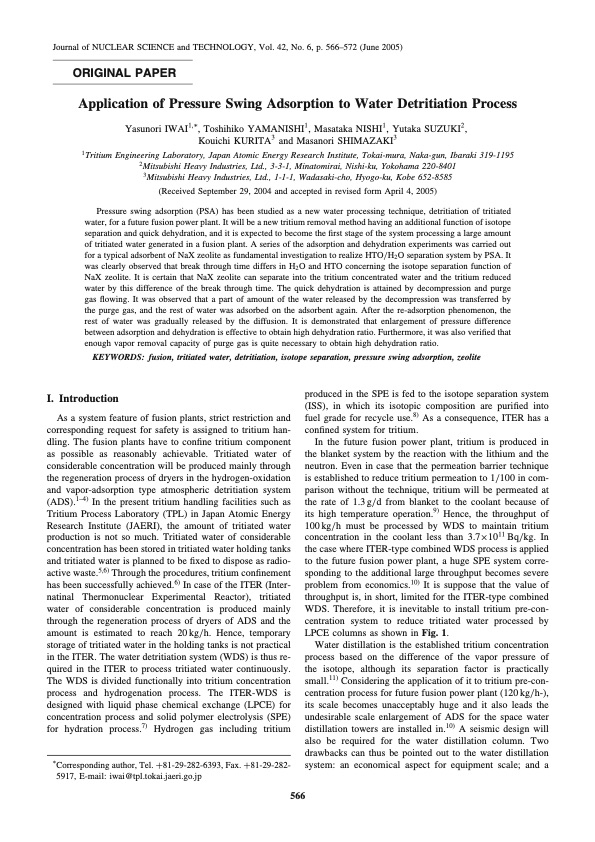
PDF Publication Title:
Text from PDF Page: 002
Journal of NUCLEAR SCIENCE and TECHNOLOGY, Vol. 42, No. 6, p. 566–572 (June 2005) ORIGINAL PAPER Application of Pressure Swing Adsorption to Water Detritiation Process Yasunori IWAI1;, Toshihiko YAMANISHI1, Masataka NISHI1, Yutaka SUZUKI2, Kouichi KURITA3 and Masanori SHIMAZAKI3 1Tritium Engineering Laboratory, Japan Atomic Energy Research Institute, Tokai-mura, Naka-gun, Ibaraki 319-1195 2Mitsubishi Heavy Industries, Ltd., 3-3-1, Minatomirai, Nishi-ku, Yokohama 220-8401 3Mitsubishi Heavy Industries, Ltd., 1-1-1, Wadasaki-cho, Hyogo-ku, Kobe 652-8585 (Received September 29, 2004 and accepted in revised form April 4, 2005) Pressure swing adsorption (PSA) has been studied as a new water processing technique, detritiation of tritiated water, for a future fusion power plant. It will be a new tritium removal method having an additional function of isotope separation and quick dehydration, and it is expected to become the first stage of the system processing a large amount of tritiated water generated in a fusion plant. A series of the adsorption and dehydration experiments was carried out for a typical adsorbent of NaX zeolite as fundamental investigation to realize HTO/H2O separation system by PSA. It was clearly observed that break through time differs in H2O and HTO concerning the isotope separation function of NaX zeolite. It is certain that NaX zeolite can separate into the tritium concentrated water and the tritium reduced water by this difference of the break through time. The quick dehydration is attained by decompression and purge gas flowing. It was observed that a part of amount of the water released by the decompression was transferred by the purge gas, and the rest of water was adsorbed on the adsorbent again. After the re-adsorption phenomenon, the rest of water was gradually released by the diffusion. It is demonstrated that enlargement of pressure difference between adsorption and dehydration is effective to obtain high dehydration ratio. Furthermore, it was also verified that enough vapor removal capacity of purge gas is quite necessary to obtain high dehydration ratio. KEYWORDS: fusion, tritiated water, detritiation, isotope separation, pressure swing adsorption, zeolite I. Introduction As a system feature of fusion plants, strict restriction and corresponding request for safety is assigned to tritium han- dling. The fusion plants have to confine tritium component as possible as reasonably achievable. Tritiated water of considerable concentration will be produced mainly through the regeneration process of dryers in the hydrogen-oxidation and vapor-adsorption type atmospheric detritiation system (ADS).1–4) In the present tritium handling facilities such as Tritium Process Laboratory (TPL) in Japan Atomic Energy Research Institute (JAERI), the amount of tritiated water production is not so much. Tritiated water of considerable concentration has been stored in tritiated water holding tanks and tritiated water is planned to be fixed to dispose as radio- active waste.5,6) Through the procedures, tritium confinement has been successfully achieved.6) In case of the ITER (Inter- natinal Thermonuclear Experimental Reactor), tritiated water of considerable concentration is produced mainly through the regeneration process of dryers of ADS and the amount is estimated to reach 20kg/h. Hence, temporary storage of tritiated water in the holding tanks is not practical in the ITER. The water detritiation system (WDS) is thus re- quired in the ITER to process tritiated water continuously. The WDS is divided functionally into tritium concentration process and hydrogenation process. The ITER-WDS is designed with liquid phase chemical exchange (LPCE) for concentration process and solid polymer electrolysis (SPE) for hydration process.7) Hydrogen gas including tritium Corresponding author, Tel. +81-29-282-6393, Fax. +81-29-282- 5917, E-mail: iwai@tpl.tokai.jaeri.go.jp produced in the SPE is fed to the isotope separation system (ISS), in which its isotopic composition are purified into fuel grade for recycle use.8) As a consequence, ITER has a confined system for tritium. In the future fusion power plant, tritium is produced in the blanket system by the reaction with the lithium and the neutron. Even in case that the permeation barrier technique is established to reduce tritium permeation to 1/100 in com- parison without the technique, tritium will be permeated at the rate of 1.3g/d from blanket to the coolant because of its high temperature operation.9) Hence, the throughput of 100kg/h must be processed by WDS to maintain tritium concentration in the coolant less than 3:71011 Bq/kg. In the case where ITER-type combined WDS process is applied to the future fusion power plant, a huge SPE system corre- sponding to the additional large throughput becomes severe problem from economics.10) It is suppose that the value of throughput is, in short, limited for the ITER-type combined WDS. Therefore, it is inevitable to install tritium pre-con- centration system to reduce tritiated water processed by LPCE columns as shown in Fig. 1. Water distillation is the established tritium concentration process based on the difference of the vapor pressure of the isotope, although its separation factor is practically small.11) Considering the application of it to tritium pre-con- centration process for future fusion power plant (120 kg/h-), its scale becomes unacceptably huge and it also leads the undesirable scale enlargement of ADS for the space water distillation towers are installed in.10) A seismic design will also be required for the water distillation column. Two drawbacks can thus be pointed out to the water distillation system: an economical aspect for equipment scale; and a 566PDF Image | Pressure Swing Adsorption to Water Detritiation Process

PDF Search Title:
Pressure Swing Adsorption to Water Detritiation ProcessOriginal File Name Searched:
PSA-Water-Detritiation-Process.pdfDIY PDF Search: Google It | Yahoo | Bing
CO2 Organic Rankine Cycle Experimenter Platform The supercritical CO2 phase change system is both a heat pump and organic rankine cycle which can be used for those purposes and as a supercritical extractor for advanced subcritical and supercritical extraction technology. Uses include producing nanoparticles, precious metal CO2 extraction, lithium battery recycling, and other applications... More Info
Heat Pumps CO2 ORC Heat Pump System Platform More Info
| CONTACT TEL: 608-238-6001 Email: greg@infinityturbine.com | RSS | AMP |